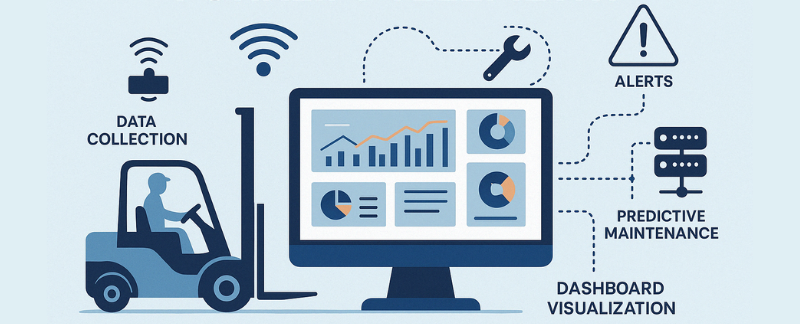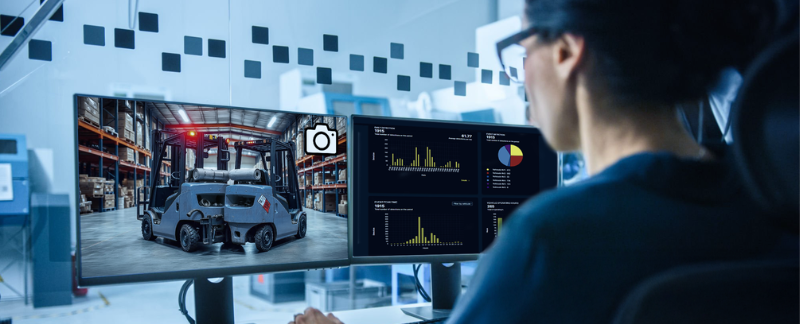A Complete Guide to Forklift Telemetry
Did you know that forklift downtime costs industries millions each year, and 70% of forklift accidents can be prevented with better visibility and data?
As industrial environments become more complex and safety-critical, companies are seeking intelligent tools to enhance fleet efficiency and prevent accidents. Forklift telemetry is emerging as a game-changer for real-time monitoring, proactive maintenance, and operator safety.
In this guide, we explore the fundamentals of forklift telemetry systems, their benefits, key components, implementation challenges, industry trends, and how Blaxtair’s AI-based systems complement telemetry for a safer, smart workplace.
What is Forklift Telemetry?
Forklift telemetry refers to the remote monitoring systems and data transmission technology used to collect, analyze, and display information about forklift performance, usage, and safety.
Core functions of forklift telemetry include:
- Monitoring: Track critical performance parameters such as engine hours, speed, load weight, and battery status.
- Tracking: Geolocalize vehicles and monitor their movement within the facility.
- Diagnostics: Identify early signs of mechanical or system failures.
- Safety integration: Monitor operator behavior and incidents in real time.
Forklift telemetry forms a key part of the industrial Internet of Things (IoT), connecting machines, systems, and people to optimize operations. When paired with Artificial Intelligence (AI), telemetry not only reports data but enables intelligent decision-making and proactive interventions.
How Does Forklift Telemetry Work?
Forklift telemetry combines several technologies to deliver meaningful insights in real time:
- Data Collection via Sensors: Sensors installed on forklifts capture data on motion, engine health, fuel usage, tilt angle, speed, load weight, and more.
- Real-Time Transmission: Data in real time is transmitted via wireless networks like Wi-Fi, 4G/5G, or LPWAN (e.g., LoRa, NB-IoT) to a central server or cloud platform.
- Data Processing and Dashboard Visualization: The system processes raw data and displays it in a user-friendly dashboard for operators, safety managers, and fleet supervisors.
- Alerts and Predictive Analytics: Telemetry platforms generate alerts for unsafe behavior, maintenance needs, or anomalies—often using machine learning algorithms to predict failures.
- Integration with WMS, ERP, and AI Systems: Forklift telemetry connects with warehouse management systems (WMS), enterprise resource planning (ERP) software, and advanced AI-powered systems like Blaxtair for seamless operations and enhanced safety.

Key Components of a Forklift Telemetry System
To fully understand the impact of forklift telemetry, it’s essential to explore the critical components that make the system function effectively. A modern forklift telemetry solution is a combination of hardware and software working together to deliver real-time insights, automate safety measures, and optimize operational performance. Here’s a breakdown of the essential building blocks:
Onboard Sensors and Control Modules
At the heart of every forklift telemetry system lies a network of onboard sensors and control modules. These smart sensors capture a wide range of operational data, including vehicle speed, engine performance, hydraulic pressure, tilt angle, load weight, lift height, brake usage, and more.
Additionally, proximity sensors, impact detectors, and gyroscopic controls provide a layer of situational awareness, helping track risky maneuvers or collision threats. These modules act as the data gateway between the machine and the central telemetry platform, ensuring all relevant parameters are continuously monitored.
Real-Time Data Transmission
Collected data must be transmitted quickly and securely to allow real-time analysis. Telemetry systems use wireless communication protocols, such as:
- Wi-Fi for local indoor environments
- 4G/5G cellular networks for larger facilities or mobile fleets
- LPWAN technologies (Low-Power Wide-Area Networks), like LoRa or NB-IoT, for low-power and long-range communication
This ensures constant data flow between forklifts and central systems, enabling instant alerts and continuous monitoring.
Centralized Dashboard and Analytics
A major advantage of forklift telemetry is the ability to visualize complex gathered data in a centralized dashboard. This user-friendly interface allows managers to monitor fleet performance and utilization, operator behavior, and machine health at a glance.
Key features often include:
- Real-time asset tracking and usage rates
- Safety indicators (near miss and collision alerts)
- Fuel or battery consumption monitoring
- Maintenance scheduling and alerts
- Operator behavior and productivity KPIs
Advanced dashboards also provide automated reporting, trend analysis, and predictive insights, helping organizations make data-driven decisions and plan for long-term efficiency improvements (proactive management).
AI-Powered Safety Enhancements
While traditional telemetry focuses on machine performance, the integration of AI-powered systems to improve safety, like Blaxtair® Pedestrian Detection cameras, takes fleet safety to a whole new level.
Blaxtair uses artificial intelligence to detect human presence in real time, differentiating between pedestrians and obstacles, and instantly alerts the operator to potential dangers. When integrated into telemetry platforms, these systems provide an extra layer of situational awareness, enabling:
- Real-time collision risk alerts
- Near-miss reporting with visual data
- Compliance tracking and safety scoring
- Combined analytics of operator behavior and near-miss events
By combining telemetry and AI, businesses can create a holistic safety ecosystem that minimizes accidents, protects workers, and supports proactive risk management.
Benefits of Forklift Telemetry
The implementation of forklift telemetry delivers significant advantages across operations, maintenance, and safety:
- Improved Operator Safety: Detects and alerts against unsafe driving, collisions, and pedestrian proximity.
- Increased Asset Utilization: Tracks forklift availability, usage patterns, and idle time to optimize deployment.
- Predictive Maintenance: Detects wear and failures before breakdowns occur, reducing costly downtime.
- Cost Savings and Productivity Boost: Reduces maintenance costs, minimizes downtime, and increases throughput.
- Data-Driven Compliance: Facilitates compliance with safety regulations through transparent logging and reporting.
Challenges in Implementing Telemetry
While the benefits are clear, deploying a forklift telemetry system comes with a few hurdles:
Data Overload and Interpretation
With large volumes of telemetry data generated daily, organizations often face challenges in filtering meaningful insights from noise without advanced analytics tools.
Cost and ROI Considerations
While implementing forklift telemetry requires upfront investment, businesses must evaluate the long-term return on investment through reduced downtime, maintenance savings, and enhanced safety.
System Integration Barriers
Integrating telemetry systems with existing warehouse management or ERP platforms can pose technical hurdles, requiring careful planning and IT alignment.
Operator Training and Change Management
Successfully adopting telemetry solutions depends on effective operator training and fostering a culture that embraces digital transformation and data-driven decision-making.
Forklift Telemetry in Action: Industry Applications
Telemetry is being adopted across a wide range of industries:
- Logistics & Warehousing: Track forklift usage, prevent collisions, and optimize picking routes.
- Manufacturing: Monitor forklift operations to align with lean production and just-in-time principles.
- Construction and Mining: Manage harsh environments with real-time alerts and maintenance tracking.
- Ports and Container Yards: Enhance container handling safety and fleet coordination over large areas.

Complementing Telemetry with AI-Based Safety Systems
Forklift telemetry becomes even more powerful when paired with AI-powered systems like Blaxtair:
- Blaxtair Pedestrian Detection detects and localizes human presence and near-misses in real time.
- Blaxtair Connect integrates with telemetry dashboards to provide relevant metrics/KPIs to make data-driven decisions with ease.
- The combination reduces accidents, ensures safer, more efficient and profitable operations, and improves incident reporting accuracy.
Together, telemetry and AI form a connected safety ecosystem—an intelligent layer of risk management for high-stakes environments.
Regulatory Considerations and Industry Standards
Telemetry systems play a critical role in ensuring compliance with safety standards and regulations such as OSHA (Occupational Safety and Health Administration), ISO, and other industry-specific guidelines.
By automating event logging, incident tracking, and performance metrics, these systems simplify audits, enhance traceability, and support continuous improvement in safety practices
Future Trends in Forklift Telemetry
As technology evolves, so does forklift telemetry. Key trends include:
- Predictive and AI-Driven Insights: Leveraging Big Data and machine learning for smart decisions.
- Telemetry-Enabled Autonomous Forklifts: Supporting self-driving warehouse equipment.
- IoT Ecosystem Integration: Connecting forklifts with broader supply chain systems, digital twins, and edge computing.
Conclusions
Forklift telemetry is no longer a luxury, it’s a strategic necessity for safety, efficiency, and competitiveness. By capturing and leveraging real-time data, companies can reduce downtime, prevent accidents, and make informed decisions.
At Blaxtair, we believe the future of industrial safety lies in combining advanced telemetry with AI-driven detection systems. Explore our intelligent solutions to take your fleet safety to the next level.
Discover how Blaxtair’s AI technologies complement your telemetry strategy today.

